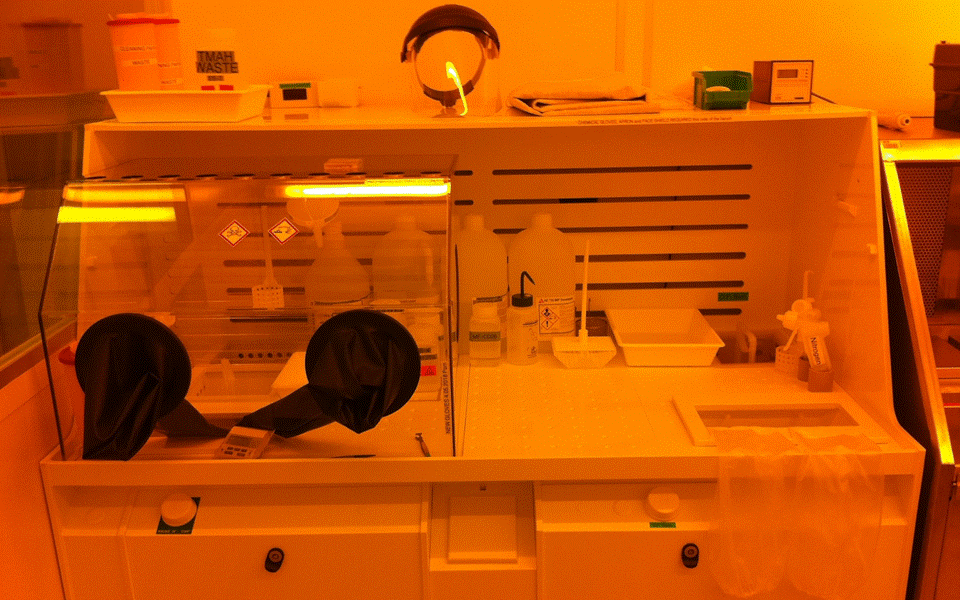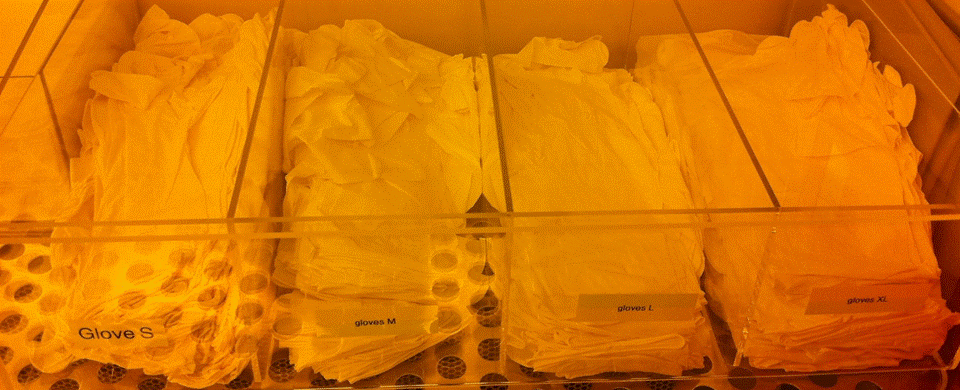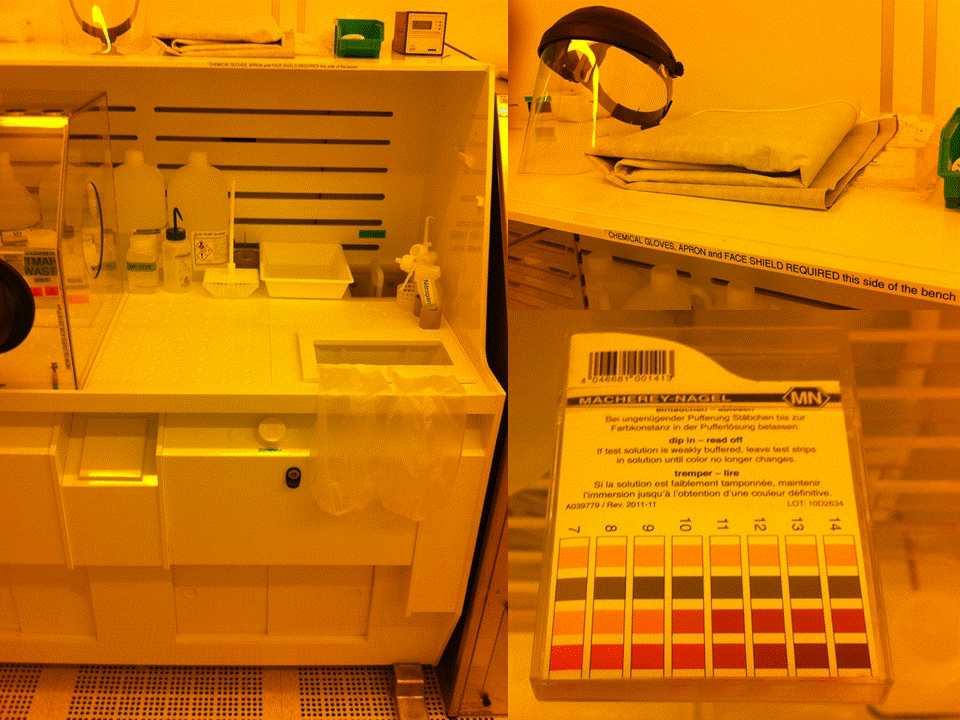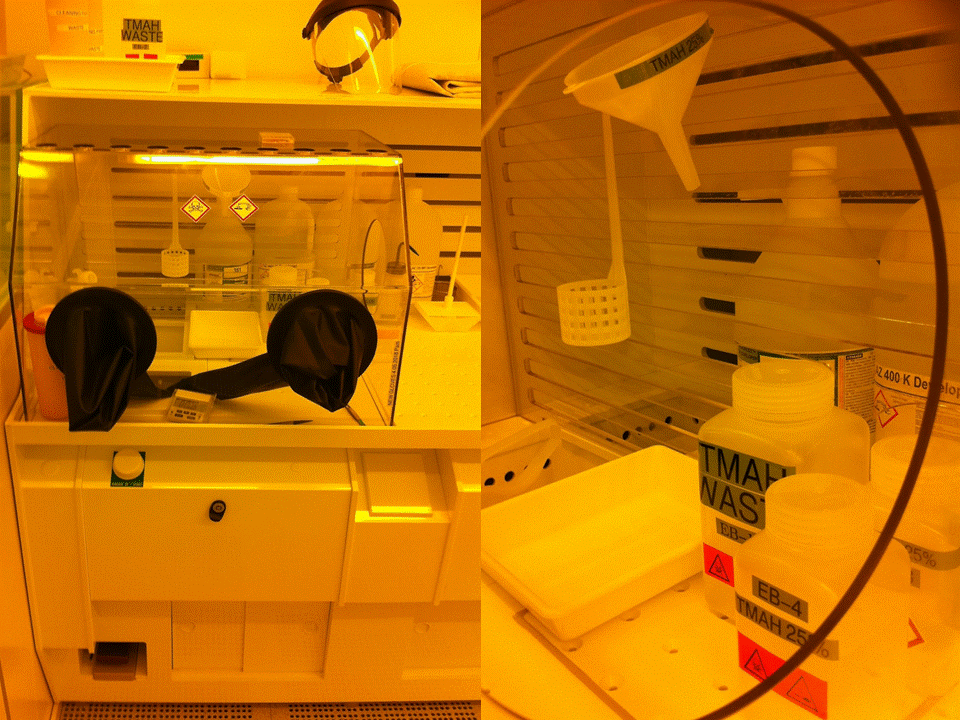SAFETY: Follow this link to read the CMi wet bench safety manual before proceeding any further !!!

The base wetbench is used for development of nLOF, HSQ and FOX16 resists, using developers that are very strong bases (pH = 13-14). It is located in the processing room of the ebeam zone (zone 7), and is dedicated to ebeam lithography ONLY !!! Following resists and solvents are currently authorized to be used there: nLOF, HSQ, FOX16, AZ726, CD26, TMAH 25% dilution. Please do not bring in any other material and do not try to process any other resist or substance there. If you have any special request, please, talk to Zdenek first.
Protective gloves

To use the base wetbench, you must were additional protective gloves plus additional protective gear specified below.
Right side of the wetbench

The right side of the base wetbench is dedicated to development of nLOF, HSQ and FOX16 resists using AZ726 or CD26 developers. To use this side of the bench, you MUST were additional protective gear, namely the apron, the face shield, and long chemical gloves.
The water gun on the right side of the bench serves also as a SAFETY shower for the whole ebeam zone.
Left side of the wetbench – the glovebox

The glovebox is dedicated to development of HSQ and FOX16 using the more concentrated (25%) TMAH. As you are protected by the thick plexiglass of the glovebox and thick rubber gloves, it is not necessary to wear the apron and face shield on this side of the wetbench.
Procedure for using the glovebox:
- Check that the glovebox and the gloves are not damaged. Report any damage immediately to the CMi staff and do not use the bench until the damage is fixed.
- Check that the workplace is clean, that there is no spilled liquid present anywhere. If you see any droplet, verify with the pH paper if it is water or TMAH. If the paper turns dark purple color, alert CMi staff. If the droplet is small, you can use the water gun and wash it off with copious amounts of water (dilution, dilution, dilution). Do not remove the used pH paper from the glovebox, dispose of it in the yellow plastic waste canister inside of the glovebox. If the canister is full, put in a new empty canister, there should be a spare placed on the top of the glovebox.
- Check that there is enough of fresh TMAH in the small bottles to enable your processing. In an emergency (weekend, night), if there is no fresh TMAH available anymore, you can develop using the TMAH from the Waste bottle (most of it has only been used to develop a single chip or wafer, and thus its contamination with residual resist is still very low.
- Check that the waste bottle is not full. There should be enough space in it for your new waste with some room at the top. The bottle should never be filled all the way to the top. If you think it is full, pleace, place a new waste bottle in, there is always a spare empty bottle at the top of the glovebox in a white plastic tray.
- Check that there is a funnel present in the glovebox.
- Place your wafer or chip and a clean glass dish or glass/teflon beaker into the glovebox.
- Push the Overflow Bath fill button on the front side of the bench to initiate filling of the overflow bath. You should see water slowly starting to fill the bath in the back side of the glove box. The resistivity meter above the glove box should show the clean water resistivity, typically around 16 MOhm or so. Remember the number it reads when the bath gets full.
- Place your hands in the black rubber gloves. You should be wearing the cleanroom gloves and the white protective gloves on top of that. Do this slowly and carefully, do not rip the gloves by pulling too strongly.
- Carefully fill the glass dish or glass/teflon beaker with sufficient amount of TMAH 25% from the small bottle.
- Develop your wafer/chip for pre-set time, typically 30-120sec.
- Remove the wafer/chip from the TMAH and drop it into the teflon holder inside of the water bath. Take care not to spill the TMAH. In case you manage to create one or several droplets, rinse them with copious amounts of water and dry the bench.
- After placing the wafer/chip into the water bath, the resistivity will drop (the ions of the developer are now flowing in the bath). You will need to wait for the resistivity to return back to its original level (a sign that no developer ions are present anymore. This may take several minutes.
- Use the waiting time to clean the used developer. Open the waste bottle, place a funnel into it, and very carefully empty the glass dish or glass/teflon beaker into the waste bottle via the funnel. Immediately rinse the empty glass dish in the water shower sink on the left side of the glovebox. To start the water shower, step on the pedal at the left bottom of the wetbench.
- After thorough rinsing, dry the glass dish with a nitrogen gun and place it in the white plastic tray inside of the glovebox.
- Remove the funnel from the waste bottle and thoroughly rinse it in the water shower sink. Dry it with nitrogen gun, and hang it back at the back side of the glovebox.
- Close the TMAH waste bottle. In case you have managed to spill a droplet of the developer onto the waste bottle, take the closed waste bottle, place it at the bottom of the water shower sink, and thoroughly spray it with water for some time. Remove and dry it with nitrogen gun before placing it back to its place in the glove box.
- When the resistivity indicates clean water only, remove your wafer/chip and dry them with nitrogen gun. Place the dry wafer/chip near the opening hole of the glovebox to be collected.
- If you managed to spill some water drops when removing the wafer from the water bath, dry them now with the nitrogen gun. The glove box should be clean and dry. If you used any paper napkin, dispose of it in the yellow plastic canister inside of the glovebox.
- Slowly free your hands from the black gloves, and via the opening hole remove your wafer/chip from the glovebox. Nothing else should leave the glovebox other than your processed wafer/chip.
When using the glovebox, please remain focused and ignore everyone else in the zone. When working in the zone, please, do not disturb the person who is working inside of the glovebox.
Selected articles about TMAH risks – recommended reading
The articles below describe several industrial accidents involving TMAH, resulting in death of the workers involved. We highly recommend that you take a look at them to get a better understanding of the risks of working with TMAH and the absolute need to observe all of the above safety procedures and protocols.
Journal of Occupational Health 50(2):99-102 · April 2008
Journal of Occupational Health 2012 Volume 55 Issue 2 Pages 120-124